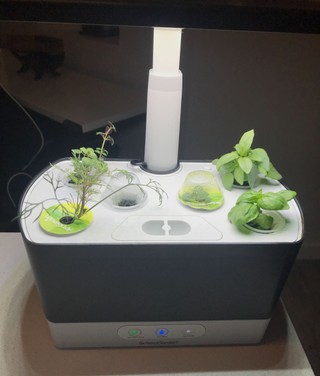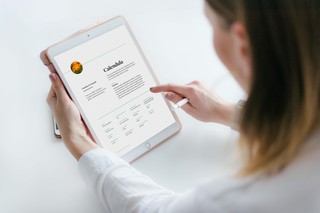Aerogarden Harvest Review 2020: Easy setup, and real grow results
- What is the Aerogarden Harvest?
- Setting up the Aerogarden Harvest
- What can the Aerogarden Harvest grow?
- Is it possible to move Aerogarden plants to soil?
- Harvesting and using herbs
- Different Aerogarden Models
- Why use the Aerogarden instead of a traditional indoor herb garden?
- Issues and Common complaints
- Can you use the system without seed pods?
- Conclusion

The powerful desire for fresh herbs year-round, grown on a kitchen countertop birthed the Aerogarden. Years later, after many generations and technical innovations, the Aerogarden remains the most popular indoor gardening system of all time.
Finally, a way for people with brown thumbs to grow all the herbs they could ever want, using a minimum of counter space. Or is it?
We wanted to find out for ourselves whether the Aerogarden lived up to the hype, so we purchased the Aerogarden Harvest with the gourmet herbs starter kit, and put to the test.
Read on to see what we found in our review of this hydroponic system.

What is the Aerogarden Harvest?
The Aerogarden offers the promise of a super simple way to grow plants indoors five times faster than in soil. Hydroponics is a way of growing higher plant yields in smaller spaces using less water than conventional methods.(1) This unit is essentially a tabletop hydroponic system occupying 11 inches by 7.5 inches of countertop real estate that takes all of the guesswork out of growing gourmet herbs indoors. The Harvest model is designed to grow six non-GMO plants at a time without any chemicals–in other words, a completely organic indoor grow operation.
A built-in, full-spectrum 20W LED light system works on a timer to provide the little garden with 17 hours of (blindingly bright) light per day. The integrated water pump continuously aerates the nutrient solution and maintains the level of root moisture necessary to keep your plants growing. All you need to do is make sure the reservoir never runs dry– made easy by the LCD display that reminds you to add water whenever it is running low.
The basis of this garden is seed pods kits placed into designated slots above the reservoir base. Most beginning gardeners are interested in growing herbs, but the number and variety of types of seed pod kits available from Aerogarden are dizzying. There are kits for herbs, salad, flowers, vegetables, and more– over 150 seed varieties in all. Our unit came with Genovese basil, Thai basil, curly parsley, mint, thyme, and dill.
Once the seed pods are in place, you simply top off the reservoir with water and then add in the growing nutrients. From there, the metal or plastic base has an LCD control panel that allows you to set the timer for the lights. The panel will also alert you when you need to add water or plant food to the unit.
Setting up the Aerogarden Harvest
This is a plug-and-play hydroponic system. What that means is that, with very little effort on your part, the Aerogarden unit will provide a nutrient solution to pre-planted seeds under optimal lighting at pre-programmed intervals. This should ensure that everything from sprouting to watering is taken care of for you.
The instructions could not be easier. After unpacking the unit and placing it on the countertop, you plug it in and insert the seed pods into the round slots on the lid of the reservoir. Next, you snap the humidity domes down on top of the grow baskets and add water to the reservoir up to the fill line. it is important to use PH neutral water, so if you know your tap water is very hard or contains a lot of chlorine, you should probably use distilled water or rainwater. Then, you mix in the nutrients as instructed, and you’re ready to program the system via the control panel.
The unit has three very basic buttons. The grow light control, which is great for turning off the light when it doesn’t fit your schedule. This light is extremely bright, and if you were trying to relax having it on would be an issue for a lot of people. The other buttons are more or less indicators for your plant food level and water system.

The water levels in the system need to stay at a certain level to ensure growing success, but fortunately, there is a reminder alert that will come on to let you know when it is time to top off the reservoir. Likewise, whenever the plant food levels need to be topped off, an alert will let you know.
Planting in the system is barely what most gardeners would call planting– you simply pop the seedpods into their slots and top them with the seed domes. The seed pods are pre-seeded growing containers that consist of a sponge-like growing medium in a plastic basket topped with a cardboard “collar.” When you snap the dome onto the pod, you are essentially creating a miniature greenhouse to help the seeds germinate quickly. As soon as you see the sprouts almost touching the dome, it is time to remove it and let the plants breathe. The seed pods also come equipped with a label, that actually serves a dual purpose. Do not remove these labels as they are designed to minimize algae bloom and mold growth.
The LED lighting system provides a full spectrum of light for the plants and is height adjustable. In the beginning, set it to the lowest possible setting to aid germination and growth, and then raise it up to accommodate the growing height of the plants. Due to the limited grow height of the Aerogarden Harvest model, it is probably best to stick to herbs, salad greens, and other low-profile plants. Regular pruning and maintenance is very important with this model because of the relatively limited space. Our dill plants grew at a much higher pace than any of the other herbs that came in the starter kit. Keep growth rates in mind when selecting what plants or herbs to grow together.
What can the Aerogarden Harvest grow?
As mentioned before, there are a huge number of seed kits available from Aerogarden. We grew the 6 pod gourmet herb seed kit, which included Genovese basil, Thai basil, mint, thyme, dill, and curly parsley. Some of the other herb kits that would perform well in the Harvest are the International Basil seed pod kit, the Pesto Seed pod kit, and the Italian Herb seed kit. You can also customize, which means you can select your own herbs such as chives or cilantro or any other herbs. It’s a perfect opportunity to branch out and explore flavors in the kitchen that you haven’t tried before.
Any of the salad greens seed pods or green smoothie seed pot kits would be perfect in this model. The kale kits are well-reviewed, but the mature plants might be a little tall for the Harvest model. If your dream is to grow flowers in your Aerogarden, your best bet is one of the cascading petunias kits, due to the low profile of the flowers. And if you’re worried about the nutritional content of hydroponically-grown herbs and vegetables, there is plenty of research indicating that hydroponic systems produce fruit and veggies with levels of nutrients equal to or greater than conventional systems.(2)
Is it possible to move Aerogarden plants to soil?
It is entirely possible to transplant Aerogarden plants to soil, but it is best to do so when the plants are still fairly small to avoid damaging the roots too much in the process. Different people have had success using various techniques, including leaving the seed pod basket and planting the whole thing or cutting the roots back and removing the roots from the basket entirely. Other folks have cut the basket away from the roots, but this will eliminate the possibility of reusing the basket with new seed pods.
The key to success with transplanting is to minimize the shock by introducing natural light slowly–a few hours a day initially–and using high-quality soil with consistent soil moisture until new roots have established. It is normal for a plant to look a little droopy and sad the first 48 hours after transplanting, but it should perk up after a couple of days.


The enthusiast's guide to herbs
We’re proud to present our new e-book, The Enthusiast’s Guide to Herbs! Learn everything you need to know about growing and caring for herbs indoors, including in-depth info cards for the 35 most commonly grown herbs.
Click the link below to find out more!
Harvesting and using herbs
Harvesting herbs grown in a soil-free medium is not very different from harvesting herbs grown in soil. For strong, bushy growth, you should begin to pinch the stems of your plants right above a growth node as soon as they are six inches tall. This will cause the plants to grow multiple stems and will increase your yield a great deal. The same is not true of veggies, so only practice this with herbs.
If you have more herbs than you can comfortably use at one time, you’ll probably want to consider preserving them for later use. You can accomplish this by drying them or by using any number of alternative preservation methods. Having some herbs in reserve is never a bad idea, and you’ll never be sorry that you took the time to save your harvest for later.
Different Aerogarden Models
While we’ve focused on the Aerogarden Harvest for this review, there are many other models available that fulfill different needs at different price points.
The Sprout
The perfect starter Aerogarden, this little unit is more versatile than meets the eye. It has a capacity of three pods and a maximum height of 15.5 inches, but that hasn’t stopped Sprout owners from growing tomatoes and peppers in it. Growers also use it to start plants in the winter to transfer to soil in the spring.
- Pros: competitive pricing, very small footprint, automated lights
- Cons: limited capacity, no water reminder, less powerful 10 watt LED lighting system
Read more reviews and purchase the Sprout at Amazon.
The Harvest
This is an ideal mid-range garden, for someone who has already dabbled in Aerogardens and wants slightly more capacity. The six-pod capacity and a 20 watt LED grow light make the Harvest good for growing a nice variety of small vegetables and herbs, but the maximum height of 17” is restrictive. Harvest model is an intermediate entry point but still easy to operate. It’s also competitively priced with the Sprout. See more photos and purchase the Harvest at Amazon.
- Pros: good price point, six pod capacity, small footprint, variety of models in different shapes and layouts, touch screen available
- Cons: maximum height limits growth, overcrowding can be a problem, no wifi offered
The Farm XL
For growers who can’t get enough of indoor growing and want to commit to growing a significant amount of food, this is the way to go. The Farm comes with a capacity for 24 pods, and heights ranging from 24 inches (Farm) to 46 inches (Farm XL). This is the largest model offered and comes with a large price tag.
- Pros: large grow capacity, bright lights, wifi and LCD touchscreen
- Cons: larger footprint, space too tight to actually grow 24 pods at a time without crowding, expensive
See more photos and purchase the Farm XL at Amazon.
Note that a few models offer wifi connectivity for controlling the settings from a smartphone. All models come with a one-year warranty and a germination guarantee that makes it possible to contact Aerogarden when seed pods fail to germinate.
Why use the Aerogarden instead of a traditional indoor herb garden?
The Aerogarden is an ideal gardening system for someone with limited growing space. People who live in small apartments or who lack yards or sunny spots should know that there is a means to grow delicious herbs and veggies indoors without even having a green thumb. This is also a wonderful way for those who aren’t outdoorsy and don’t want the hassle and mess of soil and potted plants inside their homes.
Issues and Common complaints
Mold
The most common complaint of the aerogarden is mold growth on the seed pod surfaces. The general consensus is that it is a beneficial organism that is perfectly normal and poses no threat to the germinating plants. However, plenty of Aerogarden users are unsettled by it and choose to get rid of it by gently scraping it off the surface with a fingertip, removing the dome to allow better air circulation, or by dipping a Q-tip in hydrogen peroxide and swabbing the grow surface carefully (do not touch the seedling!) We did run into some small amounts of white fuzzy mold growing on 2 of our herbs. Using hydrogen peroxide removed any issues within days.
Algae
Another issue some Aerogarden growers encounter is algae growth, which is typically the result of algae spores in the air contaminating a seed pod and then being stimulated by light hitting the area around a seed pod. Algae is a serious issue in hydroponic growing systems and should be treated as quickly as possible to avoid having overgrowth reduces the amount of oxygen in the water, which is highly detrimental to plant health.
At around the 4 week mark, we ran into an issue with algae growing around the opening of the area that our curly parsley was supposed to be growing in. After about a month it was pretty clear that our parsley seed pod wasn’t going to germinate or show any results, so we removed it, but the added exposure of light and potentially other materials caused algae to bloom. Cleaning this area up with hydrogen peroxide and occasionally adding very small amounts of hydrogen peroxide to the water source resolved this issue up without any problems.
Algae growth can be treated by adding one part hydrogen peroxide to ten parts water, but only when the plants are established enough to withstand it. Another possible solution is using grapefruit seed extract to control growth. But the best thing you can do is to limit the amount of light hitting potential growth surfaces for algae. A little algae growth doesn’t pose a significant threat to your system, but a large bloom is a huge issue.
If you have a lot of algae in your system, you’ll want to ditch your plants, flush the system completely, sterilize it and start over. To do this you’ll have to run a vinegar or bleach solution through the pump and all the lines for at least five minutes, then flush the entire system with water, allow it to dry, and then start anew.

Bright Light
The LED lighting system is extremely bright, and for folks living in small spaces, it can add an unacceptable amount of light to their homes at night. The best solution to this is to schedule the lighting cycle so that it powers down during the nighttime hours when you are home, or to place the system in a location where it is visually shielded in the evening.
Failure to Germinate
Many users complain that their seed pods sometimes fail to germinate. This is fairly normal, and the company offers a guarantee to replace any seed pods that fail in this way. However, this guarantee does not cover seed pods that germinate but fail to thrive, so don’t expect any help with that.
Can you use the system without seed pods?
Another complaint that comes up in Aerogarden reviews is that the seed pods are expensive and the varieties of plants, while vast, are still somewhat limited. Fortunately, many Aerogarden devotees have found ways to create DIY seed pods that fit the bill without breaking the bank.
The first thing you must do is to save your little domes and grow baskets after each grow. Sterilize them using hot water and soap, or even by running them through the dishwasher. Aerogarden sells packs of 50 replacement sponges to purchase at Amazon. Once you’ve got your sponges, all you need to do is source your own seeds from organic and heirloom seed suppliers. Drop a few seeds into each pod and pop them into the system. You may want to find a way to replicate the little cardboard collar that helps to shade the growing area from the lights initially.
You can also replace the plant food provided with the system with high-quality nutrients designed for hydroponic systems. Maxigrow and General Hydroponics Flora Series are extremely economical alternatives to the nutrients sold by Aerogarden.
Conclusion
Gardening newcomers looking for an easy, hassle-free way to start indoor gardening will be happy with an Aerogarden system. Even seasoned gardeners will find much to love about a countertop system where they can grow herbs during the coldest months of the year. While not 100% foolproof, this is about as close as a compact countertop hydroponic system comes to being bulletproof. While the price may seem steep at the outset, if you maintain an Aerogarden for several seasons, it will more than pay for itself.

Join our email club—get printable info cards free!
Sign up to receive our newsletter and get access to 10 printable plant info cards from our e-book for free. Also receive:
- $4 discount code for our Guide to Herbs e-book
- Semi-weekly plant inspiration & bite-size tips and tricks
Resources:
- https://www.ncbi.nlm.nih.gov/pmc/articles/PMC4483736/
- Treftz, C. and Omaye, S.T. (2015) Nutrient Analysis of Soil and Soilless Strawberries and Raspberries Grown in a Greenhouse. Food and Nutrition Sciences 6: 805-815. DOI: http://dx.doi.org/10.4236/fns.2015.69084
